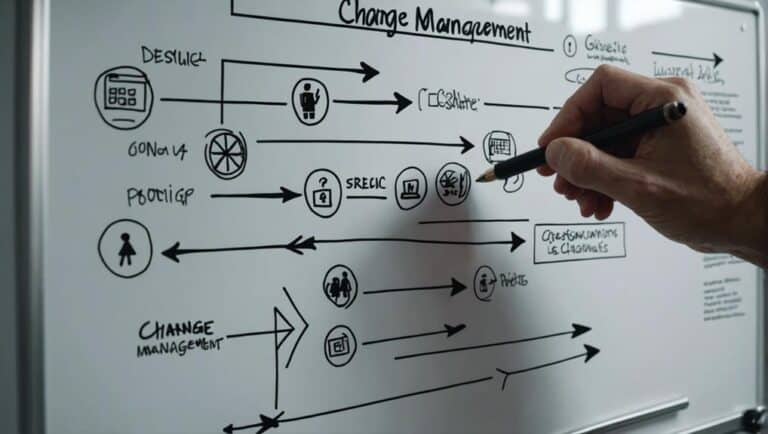You might think that implementing organizational change is solely about the end goal, but effective change management is the key to success.
Understanding the intricacies of change management can be the differentiating factor between a smooth transition and a chaotic upheaval within your organization.
As you navigate the complexities of change implementation, consider how addressing resistance, fostering communication, and engaging employees play crucial roles in the process.
By mastering these elements, you can steer your organization towards successful change outcomes.
But what happens when unexpected challenges arise?
Key Takeaways
- Change leadership inspires and motivates employees towards successful organizational change.
- Involving stakeholders at every stage ensures alignment and buy-in for change initiatives.
- Clear communication strategies foster transparency and understanding throughout the change process.
- Continuous improvement involves monitoring and evaluating efforts for sustainable organizational change.
Key Concepts in Change Management
To effectively navigate through the complexities of change management, it's crucial to grasp the fundamental principles that underpin successful organizational transitions. Change leadership plays a pivotal role in driving and implementing change within an organization. Effective change leaders inspire and motivate employees, create a clear vision for the future state, and actively involve stakeholders in the change process. By demonstrating commitment to the change initiative, leaders can instill confidence and a sense of direction among employees.
Equally important is change communication, which serves as the foundation for successful change management. Clear, transparent, and timely communication is essential in keeping employees informed, engaged, and supportive throughout the transition. Communication should be two-way, allowing for feedback, questions, and concerns to be addressed promptly. It's through effective communication that resistance to change can be minimized, and employees can feel empowered and involved in the change process. Ultimately, change leadership and change communication work hand in hand to drive successful organizational transitions.
Understanding Organizational Readiness
Understanding organizational readiness is crucial for successfully implementing change within a company, ensuring all aspects align for a smooth transition. To gauge this readiness, conducting a readiness assessment is essential. This assessment involves evaluating factors such as the organization's capacity for change, leadership support, employee engagement, and the existing change culture. By understanding where the organization stands in terms of readiness, you can identify potential barriers or resistance that may hinder the change process.
Moreover, assessing the change culture within the organization is vital. A positive change culture fosters innovation, adaptability, and open communication, making it easier to implement new initiatives. On the other hand, a resistant or hesitant change culture can impede progress and lead to implementation challenges. By recognizing the prevailing attitudes towards change within your organization, you can tailor your change management strategies to address specific needs and concerns, ultimately increasing the likelihood of successful change implementation.
Building a Change Management Plan
When crafting your change management plan, ensure you include key elements that outline the strategies and actions needed for successful implementation.
Engage stakeholders early on to gather valuable insights and secure their buy-in, fostering a sense of ownership and commitment to the change process.
Key Plan Elements
Crafting a comprehensive change management plan requires meticulous attention to key plan elements that drive successful organizational change implementation. When building your plan, consider the following crucial components:
- Leadership Support: Engage leaders at all levels to champion the change efforts and set the tone for the entire organization.
- Employee Involvement: Involve employees early on in the process to gain their buy-in and make them feel valued during the transition.
- Training Development: Develop tailored training programs to equip employees with the necessary skills and knowledge to adapt to the changes effectively.
These elements are essential for creating a robust change management plan that paves the way for a successful organizational transformation.
Stakeholder Engagement
Engage stakeholders strategically in the change management process to ensure their alignment and commitment to the organizational transformation goals. Stakeholder buy-in is crucial for the success of any change initiative. Effective communication is key to obtaining this buy-in.
Implement engagement strategies that involve stakeholders at every stage of the process. Encourage open dialogue, address concerns promptly, and solicit feedback to make them feel valued and included. By actively involving stakeholders, you can harness their diverse perspectives and expertise to drive the change forward.
Create a sense of ownership by showing how their contributions directly impact the outcomes. Ultimately, a well-crafted stakeholder engagement plan won't only secure support but also foster a culture of collaboration and shared responsibility.
Communication Strategies for Change
Crafting clear messaging is crucial as it enhances understanding among team members.
Encouraging open dialogue fosters a culture of transparency within the organization.
These strategies lay the foundation for successful change implementation.
Clear Messaging Boosts Understanding
Clear and concise messaging is essential for enhancing understanding during times of organizational change. Effective communication plays a crucial role in facilitating change adoption within your organization.
To ensure your message resonates with your audience, consider the following:
- Clarity is Key: Ensure your message is straightforward and easy to comprehend.
- Empathize with Your Audience: Understand their perspectives and address their concerns proactively.
- Consistency Matters: Maintain a consistent message across all communication channels to avoid confusion.
Open Dialogue Encourages Transparency
Encouraging open dialogue within your organization is a strategic approach that fosters transparency during times of change implementation. Honest conversations play a pivotal role in keeping employees informed and engaged throughout the change process.
By fostering an environment where individuals feel comfortable expressing their thoughts and concerns, you create a culture of trust and openness. Transparent communication is key to ensuring that everyone understands the reasons behind the changes and feels included in the decision-making process.
Encouraging dialogue also allows for feedback to be received, enabling you to address any issues promptly and make necessary adjustments. Embracing open dialogue as a communication strategy promotes collaboration and helps build a resilient organization capable of navigating change successfully.
Employee Engagement in Change
To enhance organizational change implementation, fostering active participation among employees during the change process is crucial for achieving successful outcomes. Involving employees in the change journey not only increases their commitment to the new direction but also harnesses their valuable insights and perspectives.
Here are some key strategies to enhance employee engagement during change:
- Leadership involvement: Demonstrating visible support and involvement from top management can instill confidence in employees and showcase the significance of the change initiative.
- Employee buy-in: Encouraging open communication and addressing concerns can help in gaining the trust and commitment of employees towards the change process.
- Change champions and feedback mechanisms: Identifying change champions who can influence and motivate their peers, coupled with establishing effective feedback loops, can create a culture of continuous improvement and adaptability within the organization.
Overcoming Resistance to Change
To effectively navigate through organizational change, addressing and mitigating resistance among employees is essential for ensuring successful implementation and long-term sustainability. Resistance to change is a natural reaction, often stemming from fear of the unknown, loss of control, or uncertainty about the future.
In such situations, having change champions can be instrumental in driving acceptance and enthusiasm for the new initiatives. These change champions can help communicate the benefits of the change, address concerns, and lead by example, showcasing their own willingness to adapt.
Implementing specific resistance strategies is crucial in overcoming challenges during change. Encouraging employee buy-in through transparent communication, involving them in the decision-making process, and providing support and resources can help alleviate resistance. Creating a change culture within the organization, where adaptability and innovation are valued, can also foster a more receptive environment to change initiatives.
Monitoring and Evaluating Change Efforts
Monitoring and evaluating change efforts is imperative for organizations seeking to gauge the effectiveness and impact of their implementation strategies. Progress tracking allows you to stay on course and make adjustments as needed, ensuring successful outcomes.
Data analysis provides valuable insights into how well the changes are being received and implemented throughout the organization. Performance metrics offer a quantitative way to measure the impact of the changes on key areas of the business, enabling you to make informed decisions based on concrete data.
Feedback loops are essential for continuously gathering input from employees at all levels, fostering a culture of open communication and adaptability. By consistently monitoring and evaluating change efforts through progress tracking, data analysis, performance metrics, and feedback loops, organizations can't only measure the success of their implementation strategies but also identify areas for improvement and ensure sustainable change.
Frequently Asked Questions
What Are Some Common Pitfalls to Avoid When Implementing Organizational Change?
When implementing organizational change, avoid common pitfalls like overlooking stakeholder engagement and resistance management. Ensure effective training programs and prioritize employee involvement. These steps are crucial for successful change implementation and fostering a positive organizational culture.
How Can Leaders Effectively Communicate the Reasons for Change to Employees?
To effectively communicate reasons for change to employees, engage them through clear communication strategies. Involve leadership in conveying the vision and benefits. Address resistance by fostering dialogue and listening actively. Inspire trust and collaboration to ensure successful implementation.
What Role Does Company Culture Play in Successful Change Management?
In successful change management, your company culture acts as the heartbeat driving progress. Cultural alignment fuels employee engagement, while effective resistance management and unwavering leadership support serve as the guiding forces propelling your organization towards transformational success.
How Can Change Management Be Tailored to Fit the Needs of Different Departments Within an Organization?
To tailor change management for various departments, consider department-specific strategies. Customized approaches can address unique needs, ensuring buy-in and success. Analyze each unit's culture, challenges, and goals to implement changes effectively and foster departmental growth.
How Can Organizations Sustain Change Efforts Over the Long Term?
To sustain change efforts over the long term, you must implement robust long term strategies. Focus on change sustainability by fostering a culture of adaptability and continuous improvement. Remember, change is a journey, not a destination.
Conclusion
In conclusion, change management is crucial for successful organizational change implementation. By understanding organizational readiness, building a comprehensive change management plan, utilizing effective communication strategies, engaging employees, and overcoming resistance, you can ensure the success of your change efforts.
Remember, change management isn't just important, it's absolutely essential for navigating the complexities of organizational change. So, embrace it wholeheartedly and watch your organization thrive like never before!





